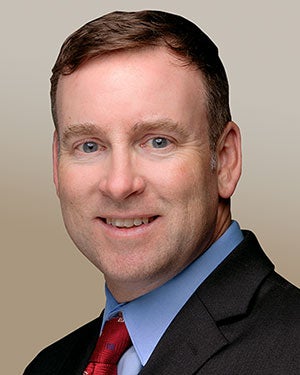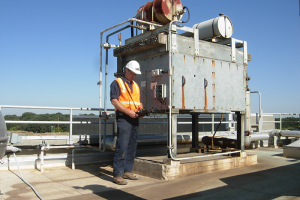A new green standard for health care facilities
Fresh from appearing in a panel presentation at the American Society for Healthcare Engineering's (ASHE's) International Summit & Exhibition on Health Facility Planning, Design & Construction on the proposed ASHRAE/ASHE Standard 189.3, Design, Construction and Operation of Sustainable High-Performance Health Care Facilities, Michael P. Sheerin, P.E., LEED AP BD+C, chairman and CEO of TLC Engineering for Architecture and chair of Standard 189.3, spoke with Health Facilities Management about the thoughts behind the document.
What is the purpose of Standard 189.3 and when did work on it begin?
ASHRAE assembled the 189.3 committee in July 2008 but the first real meeting was in January 2009. ASHRAE Standard 170, Ventilation of Health Care Facilities, had been published in 2008, so health care was just starting to come into focus for ASHRAE leadership as the special environment it is, along with the unique demands it places on designers and owner-operators. Work had started on Standard 189.1, Standard for the Design of High-Performance Green Buildings about two years earlier, and the draft versions of this standard had just been out for public review, so there was excitement for what the standard offered and also the desire within ASHRAE to clarify how this was the same or different for health care.
Standard 189.1 really was structured and intentionally created to work as a code language version of the U.S. Green Building Council (USGBC) Leadership in Energy and Environmental Design (LEED) program. It was co-sponsored by USGBC and the IES (Illuminating Engineering Society of North America), so everyone embraced that this route was a great help in the code world and enabled jurisdictions to adopt and apply a high-performance building standard with clear targets and requirements. LEED was never intended to be used that way, so even USGBC recognized that 189.1 had a beneficial role. Standard 189.3 became an outgrowth of the recognition that if 189.1 mirrored LEED, then 189.3 was needed to address the special conditions that exist in health care much like LEED for Healthcare did in the LEED program.
Which professional groups were major players in its development and how does the process work?
A wide range of industry organizations provided input to the standard during its development. We were amazed that folks were interested — even though it was focused on their area of interest — and we learned a lot in those interactions about how to address their concerns while holding true to the intent of the document. We also met great folks who appreciate and understand the open American National Standards Institute (ANSI) process and how it encourages introspection regarding what is important in the standard. We even enlisted some of them to become more involved as we completed our document. It can be a trying process at times, as we received more than 100 comments in our two early rounds of public review. We ultimately did five rounds of public review of the standard.
Our partnership with ASHE was vital to the 189.3 standard and this process because it provided feedback of the owners and operators of health care facilities who will be most impacted by the standard — and certainly the ones paying the bills to design and construct them. It also continues the trend of ASHRAE's working collaboratively with other organizations, which makes for better standards being developed, a receptive and supportive audience when the standards are published, and more industry inertia to embrace and use the standards.
How does 189.3 relate to the International Code Council's (ICC's) building codes?
That is a great question! ASHRAE has a working agreement with the ICC that channels the technical content of ASHRAE standards within the ICC codes. The best and primary example of this arrangement is that Standard 189.1 will be the technical component of the upcoming 2018 International Green Construction Code (IgCC). This approach reduces the duplication of effort for these organizations, their volunteers and staff. It also relies on the consensus-based approach of ASHRAE’s code development process to ensure that all voices are heard. Our committee is working with ASHRAE to determine the best method to integrate into this workflow with our standard. We are going to be most useful and supportive to our ASHE partners and designers of health care facilities by being part of a promulgated code such as the IgCC.
How is 189.3 different from LEED for HC?
We hope that the users of our standard will benefit from the similarity in structure between these documents. For instance, the categories — such as site, water, energy and materials — have mandatory provisions, just as in LEED HC. But, instead of the points-based approach of LEED HC, the 189.3 standard is built to define minimum criteria. There is certainly alignment in many senses and specifics, but differences in approach. The flexibility within our standard is provided by offering a prescriptive or performance approach to satisfying many components.
I should also mention that Standard 189.3 has a section titled “Emissions, Effluents and Pollution Control” that addresses such items as high-level disinfection chemicals management and pharmaceuticals management on a basic level. While this may seem fundamental, it serves as a reminder and advisory function to users, operators and local authorities who may infrequently deal with the complex and hazardous processes that go on within a health care facility.
How does Standard 189.3 handle water and energy conservation?
It is important to understand that Standard 189.3 builds on the great material in Standard 189.1, so unless information in Standard 189.3 modifies, deletes or adds new sections — typically to deal with health care-specific issues — the provisions of Standard 189.1 apply.
The general premise is that reducing water use is accomplished by defining the maximum flow rate of the fixtures and systems that will be installed. The water-use efficiency section of Standard 189.1 has great detail and covers this extensively for site and building uses, so our committee simply addressed the subset of health care conditions, such as a hand-washing lavatory sink faucet being allowed to use up to one-half gallon per minute of water.
Energy conservation is a complicated business so this section addresses defining energy efficiency across a wide variety of building systems to achieve that goal. This section of the standard has mandatory provisions and then the user can follow a prescriptive or a performance path to comply.
What recommendations does Standard 189.3 make regarding indoor environmental quality?
As expected, we reference ASHRAE 170, Ventilation of Health Care Facilities, as the basis of design for achieving indoor air quality. We also specify the emissions criteria contributed by materials so that adhesives and sealants, paints and coatings, desks and office furniture, and ceiling and wall systems do not negatively impact the environmental quality of the spaces in the facility.
Where does 189.3 stand in the approval process now?
We have completed our document and voted for publication. We have been approved by our ASHE co-sponsors and ASHRAE as well, so that is exciting. It is at ANSI now for its certification. ANSI doesn’t evaluate the technical content, but rather reviews to confirm that the consensus standard process has been followed. If all goes as planned, it will be published by the time this interview is printed. That will be a welcomed event!
Do you see Standard 189.3 development as an ongoing process?
Yes. When we voted to approve our document for publication, we also voted to become a continuous maintenance committee. We recognize that our connectivity with 189.1 and the elements of 90.1 that are part of 189.1 are changing often, so we will need to be involved in those efforts and determine how they best serve our users. We also need to continually evolve as a stretch standard.





